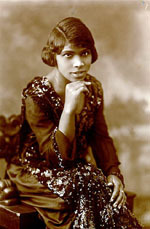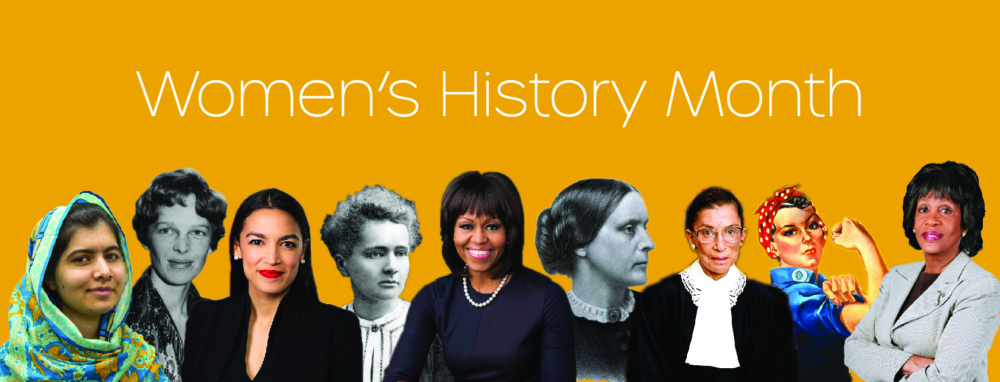 Music
Music
Sources: Wikipedia, Connecticut Women’s Hall of Fame,
Marian Anderson (February 27, 1897 – April 8, 1993, aged 96) Born in Philadelphia, Marian Anderson was a world-renowned American contralto. Anderson and her husband were Danbury residents for over 50 years.
Marian Anderson triumphed over the legacy of poverty and racial discrimination to become the most famous opera singer of the 20th century. She was the first African American to perform with the Metropolitan Opera, and her Easter Sunday concert in 1939, before 75,000 people at the Lincoln Memorial, is hailed as a defining moment in the history of civil rights in the United States.
Marian Anderson did not set out to shatter racial barriers; she was a classical musician who wished to sing and perform. Nevertheless, Anderson’s resilience, perseverance and dignity not only inspired younger African-American women in the opera world, but also broke new ground on the road to a more just and equal society.
When Anderson was 12, her father received a head injury while working at the Reading Terminal and soon afterwards died, he was 37 years old. Marian and her family moved into the home of her father’s parents, Benjamin and Isabella Anderson. Her grandfather had been born a slave and had been emancipated in the 1860s. He relocated to South Philadelphia, the first of his family to do so. Anderson was raised by her widowed mother who took in laundry to support three children.
At the age of six, she joined the choir of the Union Baptist Church, soon attracting the notice of the director. As a teenager, she remained active in her church’s musical activities, and was heavily involved in the adult choir. She became a member of the Baptists’ Young People’s Union and the Camp Fire Girls, which provided her with some limited musical opportunities. The People’s Chorus of Philadelphia and the pastor of her church, Reverend Wesley Parks, along with other leaders of the black community, raised the money she needed to get singing lessons with Mary Saunders Patterson and to attend South Philadelphia High School, where she graduated in 1921.
After high school, Anderson applied to an all-white music school, the Philadelphia Music Academy (now University of the Arts), but was turned away because she was black. The woman working the admissions counter replied, “We don’t take colored” when she tried to apply. Undaunted, Anderson pursued studies privately in her native city through the continued support of the Philadelphia black community, first with Agnes Reifsnyder, then Giuseppe Boghetti. She met Boghetti through the principal of her high school.
Giuseppe Boghetti, entered his talented student in a New York Philharmonic voice competition. Competing against 300 other vocalists, Anderson took first prize, was signed by a concert manager and began her performance career.
Anderson spent the early 1930s in Europe, touring the continent and honing her operatic skills. When the impresario Sol Hurok heard her sing in Paris, he persuaded Anderson to return to the United States and remained her manager for the rest of her career. Anderson’s homecoming was met with accolades after a performance in New York about which the New York Times’ Howard Taubman wrote that Anderson had “returned to her native land one of the greatest singers of her time.” Legendary conductor Arturo Toscanini would remark in 1935 that “a voice like hers is heard once in a hundred years.”
Anderson’s accomplishments as a singer did not make her immune to the Jim Crow laws in the 1930s. Although she gave approximately seventy recitals a year in the United States, Anderson was still turned away by some American hotels and restaurants. Albert Einstein, a champion of racial tolerance, hosted Anderson on many occasions, the first being in 1937 when she was denied a hotel room while performing at Princeton University. Einstein’s first hosting of Anderson became the subject of a play, “My Lord, What a Night,” in 2021.
It was not until 1939 that deeply ingrained prejudices resulted in the incident that made Anderson a household name. Hurok tried to book her at Constitution Hall, the national headquarters of the Daughters of the American Revolution (DAR), and was told all of the dates were taken. In truth, the D.A.R. rejected Anderson because of race, under a “white performers-only” policy in effect at the time. At that time Washington, D.C. was a segregated city, and black patrons were upset that they would have to sit at the back of Constitution Hall. Furthermore, Constitution Hall did not have the segregated public bathrooms required by DC law at the time for such events. Other DC venues were not an option; the District of Columbia Board of Education declined a request for the use of the auditorium of a white public high school.
In the ensuing furor, thousands of DAR members, including First Lady Eleanor Roosevelt, resigned from the organization. Roosevelt wrote to the DAR: “I am in complete disagreement with the attitude taken in refusing Constitution Hall to a great artist … You had an opportunity to lead in an enlightened way and it seems to me that your organization has failed.” Author Zora Neale Hurston criticized Eleanor Roosevelt’s public silence about the similar decision by the District of Columbia Board of Education.
As the controversy grew, the American press overwhelmingly supported Anderson’s right to sing. The Philadelphia Tribune wrote, “A group of tottering old ladies, who don’t know the difference between patriotism and putridism, have compelled the gracious First Lady to apologize for their national rudeness.” The Richmond Times-Dispatch wrote, “In these days of racial intolerance so crudely expressed in the Third Reich, an action such as the D.A.R.’s ban … seems all the more deplorable.”
Vindication for Anderson came when Mrs. Roosevelt persuaded Harold Ickes, the Secretary of the Interior, to arrange an Easter Sunday concert at the Lincoln Memorial. In addition to the 75,000 people who gathered at the Memorial, millions more listened on the radio as Anderson sang a stirring rendition of “My Country Tis of Thee” that quickly became a milestone in the emerging civil rights movement. History notes that Anderson’s performance inspired 10-year-old Martin Luther King, Jr. who later mentioned it in a public speaking contest.
During World War II and the Korean War, Anderson entertained troops in hospitals and at bases. In 1943, she sang at the Constitution Hall, at the invitation by the DAR to perform before an integrated audience as part of a benefit for the American Red Cross. She said of the event, “When I finally walked onto the stage of Constitution Hall, I felt no different than I had in other halls. There was no sense of triumph. I felt that it was a beautiful concert hall and I was very happy to sing there.” In contrast, the District of Columbia Board of Education continued to bar her from using the high school auditorium in the District of Columbia.[1]
In 1955 that she became the first African American to sing in a major role at the Metropolitan Opera, performing in Verdi’s Ballo in Maschera.
In 1957, she sang for President Dwight D. Eisenhower‘s inauguration, and was elected Fellow of the American Academy of Arts and Sciences. In 1958, she was officially designated a delegate to the United Nations, a formalization of her role as “goodwill ambassadress” of the U.S.
On January 20, 1961, she sang for President John F. Kennedy‘s inauguration, and in 1962 she performed for President Kennedy and other dignitaries in the East Room of the White House and toured Australia. She was active in supporting the civil rights movement during the 1960s. She performed benefit concerts in aid of the America-Israel Cultural Foundation, the National Association for the Advancement of Colored People and the Congress of Racial Equality.
In 1963, she sang at the March on Washington for Jobs and Freedom. That same year, she received one of the newly reinstituted Presidential Medal of Freedom awarded for “especially meritorious contributions to the security or national interest of the United States, World Peace or cultural or other significant public or private endeavors.”
On Saturday October 24, 1964, Anderson began her international farewell tour at Constitution Hall, which ended on April 18, 1965, at Carnegie Hall.
Although Anderson retired from singing in 1965, she continued to appear publicly. She often narrated Aaron Copland‘s Lincoln Portrait, with her nephew James DePriest conducting.
On July 17, 1943, Anderson became the second wife of architect Orpheus H. “King” Fisher (1900–1986) in Bethel. Fisher had asked her to marry him when they were teenagers, but she declined at that time because she feared it would have forestalled her music career. The wedding was a private ceremony performed by United Methodist pastor Rev. Jack Grenfell and was the subject of a short story titled “The ‘Inside’ Story,” written by Rev. Grenfell’s wife, Dr. Clarine Coffin Grenfell, in her book Women My Husband Married, including Marian Anderson.
In 1940, seeking a retreat away from the public eye, Anderson and Fisher purchased a three-story Victorian farmhouse on a 100-acre farm in Danbury, after an exhaustive search throughout New York, New Jersey, and Connecticut. Through the years, he built many structures on the property, including an acoustic rehearsal studio he designed for his wife.
Named Marianna Farm, the farm was one of 60 sites on the Connecticut Freedom Trail. The studio was moved to downtown Danbury as the Marian Anderson studio.
As a town resident, Anderson wished to live as normally as possible, visiting the Danbury State Fair. Singing at Danbury city hall for the lighting of Christmas ornaments. She gave a concert at the Danbury High School. She served on the board of the Danbury Music Center and supported the Charles Ives Center for the Arts, and the Danbury Chapter of the NAACP.
In 1986, Orpheus Fisher died after 43 years of marriage. Anderson remained in residence at Marianna Farm until 1992, one year before her death. The property was sold to developers, but various preservationists as well as the City of Danbury fought to protect Anderson’s studio.
Their efforts proved successful, and the Danbury Museum and Historical Society received a grant from the state of Connecticut, relocated and restored the structure, and opened it to the public in 2004. In addition to seeing the studio, visitors can see photographs and memorabilia from milestones in Anderson’s career.

